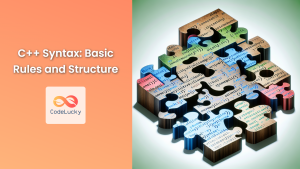C++20 introduced a powerful feature called concepts, which revolutionizes the way we work with templates. Concepts provide a mechanism to place constraints on template parameters, making template code more expressive, easier to read, and simpler to debug. In this comprehensive guide, we'll dive deep into C++ concepts, exploring their syntax, usage, and benefits with practical examples.
Understanding C++ Concepts
Concepts are named boolean predicates on template parameters that are evaluated at compile-time. They allow you to specify requirements for template arguments, ensuring that only types meeting specific criteria can be used with a particular template.
🔍 Key Benefits of Concepts:
- Improved error messages
- Better code documentation
- Overload resolution based on constraints
- Simplified template metaprogramming
Let's start with a simple example to illustrate the basic syntax of concepts:
#include <concepts>
#include <iostream>
template <typename T>
concept Numeric = std::is_arithmetic_v<T>;
template <Numeric T>
T add(T a, T b) {
return a + b;
}
int main() {
std::cout << add(5, 3) << std::endl; // Works fine
std::cout << add(3.14, 2.86) << std::endl; // Also works
// std::cout << add("Hello", "World") << std::endl; // Compilation error
return 0;
}
In this example, we define a concept Numeric that constrains the template parameter T to arithmetic types. The add function template then uses this concept to ensure it only works with numeric types.
Defining and Using Concepts
Concepts can be defined using the concept keyword followed by a name and a constraint expression. Let's explore more complex concept definitions:
#include <concepts>
#include <iostream>
#include <vector>
// Simple concept
template <typename T>
concept Addable = requires(T a, T b) {
{ a + b } -> std::same_as<T>;
};
// More complex concept
template <typename T>
concept Sortable = requires(T& a) {
{ a.begin() } -> std::same_as<typename T::iterator>;
{ a.end() } -> std::same_as<typename T::iterator>;
requires std::totally_ordered<typename T::value_type>;
};
// Using concepts in function templates
template <Addable T>
T sum(const std::vector<T>& v) {
T result = T();
for (const auto& elem : v) {
result = result + elem;
}
return result;
}
template <Sortable T>
void sort_and_print(T& container) {
std::sort(container.begin(), container.end());
for (const auto& elem : container) {
std::cout << elem << " ";
}
std::cout << std::endl;
}
int main() {
std::vector<int> v1 = {5, 2, 8, 1, 9};
std::vector<std::string> v2 = {"apple", "banana", "cherry"};
std::cout << "Sum of v1: " << sum(v1) << std::endl;
// std::cout << "Sum of v2: " << sum(v2) << std::endl; // Compilation error
sort_and_print(v1);
sort_and_print(v2);
return 0;
}
In this example, we define two concepts:
Addable: Requires that the type supports addition.Sortable: Requires that the type hasbegin()andend()methods returning iterators, and its value type is totally ordered.
We then use these concepts to constrain our function templates sum and sort_and_print.
Concept Composition and Refinement
Concepts can be composed and refined to create more complex constraints. Let's look at an example:
#include <concepts>
#include <iostream>
#include <vector>
#include <list>
template <typename T>
concept Container = requires(T c) {
{ c.begin() } -> std::same_as<typename T::iterator>;
{ c.end() } -> std::same_as<typename T::iterator>;
{ c.size() } -> std::same_as<typename T::size_type>;
};
template <typename T>
concept Resizable = Container<T> && requires(T c) {
{ c.resize(typename T::size_type()) };
};
template <Container T>
void print_size(const T& container) {
std::cout << "Size: " << container.size() << std::endl;
}
template <Resizable T>
void double_size(T& container) {
container.resize(container.size() * 2);
}
int main() {
std::vector<int> vec = {1, 2, 3, 4, 5};
std::list<int> lst = {1, 2, 3, 4, 5};
print_size(vec);
print_size(lst);
double_size(vec);
// double_size(lst); // Compilation error: std::list is not resizable
print_size(vec);
return 0;
}
Here, we define a Container concept and then refine it to create a Resizable concept. The Resizable concept includes all the requirements of Container plus the ability to be resized.
Concepts and Class Templates
Concepts can also be used with class templates. Let's see an example:
#include <concepts>
#include <iostream>
#include <vector>
#include <list>
template <typename T>
concept Numeric = std::is_arithmetic_v<T>;
template <Numeric T>
class Statistics {
private:
std::vector<T> data;
public:
void add(T value) {
data.push_back(value);
}
T mean() const {
if (data.empty()) return T();
T sum = T();
for (const auto& value : data) {
sum += value;
}
return sum / static_cast<T>(data.size());
}
void print_data() const {
for (const auto& value : data) {
std::cout << value << " ";
}
std::cout << std::endl;
}
};
int main() {
Statistics<int> int_stats;
int_stats.add(1);
int_stats.add(2);
int_stats.add(3);
int_stats.add(4);
int_stats.add(5);
std::cout << "Integer data: ";
int_stats.print_data();
std::cout << "Mean: " << int_stats.mean() << std::endl;
Statistics<double> double_stats;
double_stats.add(1.5);
double_stats.add(2.7);
double_stats.add(3.2);
double_stats.add(4.9);
double_stats.add(5.1);
std::cout << "Double data: ";
double_stats.print_data();
std::cout << "Mean: " << double_stats.mean() << std::endl;
// Statistics<std::string> string_stats; // Compilation error
return 0;
}
In this example, we define a Statistics class template that is constrained to work only with numeric types. This ensures that operations like addition and division are valid for the template parameter.
Concepts and SFINAE
Concepts provide a more readable and maintainable alternative to SFINAE (Substitution Failure Is Not An Error). Let's compare SFINAE and concepts:
#include <concepts>
#include <iostream>
#include <type_traits>
#include <vector>
// SFINAE approach
template <typename T>
typename std::enable_if<std::is_integral<T>::value, bool>::type
is_even_sfinae(T value) {
return value % 2 == 0;
}
// Concepts approach
template <typename T>
concept Integral = std::is_integral_v<T>;
template <Integral T>
bool is_even_concept(T value) {
return value % 2 == 0;
}
int main() {
std::cout << "Using SFINAE:" << std::endl;
std::cout << "Is 4 even? " << is_even_sfinae(4) << std::endl;
std::cout << "Is 7 even? " << is_even_sfinae(7) << std::endl;
// std::cout << "Is 3.14 even? " << is_even_sfinae(3.14) << std::endl; // Compilation error
std::cout << "\nUsing Concepts:" << std::endl;
std::cout << "Is 4 even? " << is_even_concept(4) << std::endl;
std::cout << "Is 7 even? " << is_even_concept(7) << std::endl;
// std::cout << "Is 3.14 even? " << is_even_concept(3.14) << std::endl; // Compilation error
return 0;
}
As you can see, the concept-based approach is much more readable and straightforward compared to the SFINAE approach.
Advanced Concept Features
Let's explore some advanced features of concepts:
Concept Disjunction and Conjunction
Concepts can be combined using logical operators:
#include <concepts>
#include <iostream>
#include <vector>
#include <list>
template <typename T>
concept Addable = requires(T a, T b) { { a + b } -> std::same_as<T>; };
template <typename T>
concept Subtractable = requires(T a, T b) { { a - b } -> std::same_as<T>; };
template <typename T>
concept Numeric = Addable<T> && Subtractable<T>;
template <typename T>
concept Container = requires(T c) {
{ c.begin() } -> std::same_as<typename T::iterator>;
{ c.end() } -> std::same_as<typename T::iterator>;
};
template <typename T>
concept VectorOrList = std::same_as<T, std::vector<typename T::value_type>> ||
std::same_as<T, std::list<typename T::value_type>>;
template <Numeric T>
T calculate(T a, T b) {
return a + b - a;
}
template <Container T>
requires VectorOrList<T>
void print_first_last(const T& container) {
if (!container.empty()) {
std::cout << "First: " << *container.begin()
<< ", Last: " << *std::prev(container.end()) << std::endl;
}
}
int main() {
std::cout << "Numeric calculation: " << calculate(5, 3) << std::endl;
std::vector<int> vec = {1, 2, 3, 4, 5};
std::list<double> lst = {1.1, 2.2, 3.3, 4.4, 5.5};
print_first_last(vec);
print_first_last(lst);
return 0;
}
In this example, we use concept conjunction (&&) to define Numeric, and concept disjunction (||) to define VectorOrList.
Constrained Auto
Concepts can be used with auto to create constrained deduction:
#include <concepts>
#include <iostream>
#include <vector>
template <typename T>
concept Printable = requires(std::ostream& os, const T& t) {
{ os << t } -> std::same_as<std::ostream&>;
};
void print_value(const Printable auto& value) {
std::cout << value << std::endl;
}
int main() {
print_value(42);
print_value("Hello, World!");
print_value(3.14159);
std::vector<int> vec = {1, 2, 3};
// print_value(vec); // Compilation error: std::vector<int> is not Printable
return 0;
}
Here, Printable auto in the function parameter list constrains the deduced type to satisfy the Printable concept.
Best Practices and Considerations
When working with concepts, keep these best practices in mind:
- 🎯 Be specific: Define concepts that are as specific as possible to your requirements.
- 🔄 Reuse concepts: Compose larger concepts from smaller, reusable ones.
- 📚 Use standard concepts: Utilize concepts from the standard library when applicable.
- 🧪 Test thoroughly: Ensure your concepts work correctly with various types.
- 📝 Document well: Clearly explain the requirements of your concepts in comments or documentation.
Conclusion
C++20 concepts provide a powerful tool for constraining templates, improving code readability, and catching errors at compile-time. By using concepts, you can write more expressive and robust template code, leading to better software design and easier maintenance.
As you continue to work with C++, make sure to leverage concepts in your template metaprogramming toolbox. They offer a cleaner syntax compared to traditional SFINAE techniques and can significantly improve the clarity of your code.
Remember, the key to mastering concepts is practice. Experiment with different constraint combinations, explore the standard library concepts, and gradually incorporate them into your C++ projects. Happy coding!
















